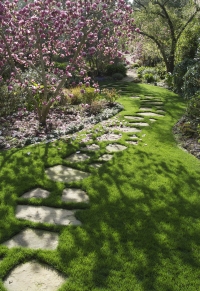How to Get Your Lawn Ready for Spring
As the world outside finally begins to turn green after a long winter, it’s time once again to pay attention to your lawn. Spring is a sensitive time for your yard – the soil is spongy, the plants are tender, and the weather is unpredictable. Your lawn will thank you for being gentle this time of year, but it will also thank you for addressing a few important spring tasks.
Here’s how to go about taking care of your lawn in the spring.
Types of Grass
Spring lawn care depends on the type of grass you are growing:
- Cool-season grasses include fescue, bluegrass, and rye. They have two growth spurts – a moderate one in the spring, and a big one in the fall. They go dormant and can struggle in hot summer months, so the focus of spring care is strengthening the plants for summer.
- Warm-season grasses – such as Zoysia, St. Augustine, centipede, and Bermuda – thrive in the heat and go dormant during winter. They begin growing after the last spring frost and really get going by midsummer.
Understanding the type of grass you have and its peak growing season will help you address lawn care tasks at the correct time.
Clean Up – Gently!
Avoid heavy yard work in the spring until the soil dries out – foot traffic and hard raking can compact or disturb soggy soil and damage tender, new grass shoots. Once the soil is good and dry, give your lawn a good spring cleaning to encourage grass growth and discourage pests and diseases. Remove leaves and fallen debris, and gently rake to fluff up and separate the grass shoots.
In areas with heavy snowfall, leftover snow piles can smother the grass underneath and foster mold growth. As the weather warms, spread snow piles out with a shovel to encourage melting.
Controlling Weeds
Spring is the best time to prevent weeds by using pre-emergent weed control, which work by preventing weed seeds from germinating. Your first application of a pre-emergent herbicide should occur just as the forsythia bushes finish blooming in spring – that should stop crabgrass and other weeds before they have a chance to grow.
Both cool-season and warm-season lawns benefit from weed prevention in the spring. Pre-emergent herbicides work for about three months, so plan on a second application during the summer.
Seeding and Planting
In the spring, gardeners have to choose between weed control and lawn seeding. Pre-emergent herbicides prevent grass seed from sprouting too, so you can’t do both – the herbicide will be active for up to 12 weeks, which means you’ll miss the spring planting season.
If your focus this spring is on filling in bare spots or establishing a new lawn, time your activities according to the type of grass:
- Cool-season grasses can be planted as soon as the air temperatures get into the 60s and soil temperatures are in the 50s. Plant as soon as temperatures allow to give the seedlings a chance to get established before hot weather hits. Fall is a better time to plant cool-season grasses, so use spring planting for patching bare spots, and be prepared to keep your lawn well-watered during the summer.
- Warm-season grasses can be planted when air temperatures are in the 70s, soil temperatures are in the 60s, and all danger of frost has passed. Late spring is the best time to plant warm-season grasses.
Fertilizing
The type of grass you have also influences when and how you should fertilize your lawn:
- Cool-season grasses: Resist the urge to heavily fertilize your lawn in the spring. Spring feeding encourages rapid tender growth that will struggle to survive the heat of summer, particularly in drought-prone areas. If your lawn is in bad shape, fertilize lightly in spring with a balanced, slow-release fertilizer. Save the heavier feedings for fall, when cool-season grasses are at their peak growing season.
- Warm-season grasses: Fertilize in late spring as soon as the lawn “greens up” and begins actively growing. This is usually in April or May, after the last frost.
Soil Problems
Spring is a great time to conduct a soil test to find out if your soil needs any amendments. You can apply lime to acidic soil (pH below 6) anytime during the growing season, as long as the grass isn’t wilted or covered with frost. Early spring can be a great time to apply lime if you’ll be planting new grass that year.
Don’t apply lime within 3 weeks of fertilizing, as the ingredients can react and become less effective. Follow the recommendations of your soil test kit and your purchased amendments for proper dosage.
Other Spring Lawn Tasks
Aeration: is best done during your lawn’s peak growing season. For warm-season grasses, this means early to mid-summer. For cool-season grasses, aeration is best saved for fall but can be repeated in spring if the soil is extremely compacted. Wait until your lawn has been mowed 2-3 times in the season, so you’ll be sure it is growing fast enough to recover from the aeration.
Dethatching: also best done during peak growing season, right before aerating.
Mowing: Begin mowing as soon as your lawn needs it – grass blades do best when you cut no more than a third of the blade’s length at a time.
Watering: Once your grass starts growing, you’ll need to make sure your lawn gets at least 1? of water per week. Until then, you can water less frequently but remember that cold air is very drying to plants and lawns.
Insect control: Spring is a good time to address problems with fire ants. Many other insects, such as grubs and mole crickets, may also cause damage to your lawn in spring but are more effectively controlled later in the summer.
Lawn Equipment: Sharpen the blade and tune up your lawn mower, as well as other lawn equipment, to make summer mowing a breeze!
Content provided courtesy of:
| Blueprint Building Inspections (416) 694-5859 www. |


You must be logged in to post a comment.